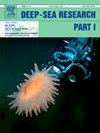墨西哥湾南部海域翼足类动物的聚集(2015年6月)
IF 2.1
3区 地球科学
Q2 OCEANOGRAPHY
Deep-Sea Research Part I-Oceanographic Research Papers
Pub Date : 2025-02-01
DOI:10.1016/j.dsr.2024.104431
引用次数: 0
摘要
2015年6月对墨西哥湾南部海域翼足类动物群落结构进行了分析。本研究首次采用形态学和分子生物学相结合的方法对华南地区翼足类动物进行鉴定。共鉴定了32个翼足动物类群,其中12个成功测序,至少有一个位点(COI和28S)成功测序。分子数据支持其中一半的分类一致性。然而,尽管其他6个分类群在形态上存在差异,但分子证据显示出较低的遗传变异性,从而导致属水平的分辨率。在采样期间,所有采样区域的海洋条件都非常均匀,表面温度高(SST >27.5°C),叶绿素浓度低(CHL <0.5)。然而,CHL与翼足类总丰度、食草动物丰度和食肉动物丰度呈显著正相关,表明翼足类群落存在自下而上的控制。生态分析结果表明,4种翼足类占总丰度的63%,分别是Heliconoides inflatus、Creseis conica、Limacina trochiformis和Creseis acicula。聚类分析显示存在4个组合,按其分布和种类组成命名。海洋组合在采样区内分布较广,主要有H. inflatus、Styliola subbula和Limacina lesueurii等一组海洋物种,与测量的环境变量无明显相关性。翼足类的丰度以沿海海洋组合最高;以浅海种C. conica和L. trochiformis占优势,且与CHL浓度呈显著正相关。另外两个组合分布在西北高分层低CHL值的反气旋涡附近,在海生螺(H. inflatus)、针状螺(C. acicula)和亚种(S. subbula)中呈现混合优势。海洋组合被认为是南墨西哥湾的基础翼足类群落。东南沿海洋流偏转,将营养物和生物群带入大洋,使CHL浓度相对富集。西北环流反气旋涡的存在,增加了分层,加剧了少营养条件,导致翼足类群落较好地适应了这些少营养条件。本文章由计算机程序翻译,如有差异,请以英文原文为准。
Pteropod assemblages in the oceanic waters of the southern Gulf of Mexico (June 2015)
The pteropod community structure in the oceanic waters of the southern Gulf of Mexico (sGoM) was analyzed in June 2015. For the first time, we used an integrative morphological and molecular approach for pteropod identification in the sGoM. A total of 32 pteropod taxa were morphologically identified from the oceanic waters of which 12 were successfully sequenced, at least for one of the loci implemented (COI and 28S). The molecular data support the taxonomic identity of half of them. However, despite the morphological differences in the other six taxa, the molecular evidence displayed low genetic variability, resulting in a resolution to the genus level. During the sampling campaign, the oceanographic conditions were very homogeneous in all the sampled areas, with high surface temperatures (SST >27.5 °C) and low chlorophyll (CHL <0.5) concentrations. Nevertheless, CHL presented a positive and significant correlation with total pteropod abundance, herbivores abundance and carnivores abundance, suggesting a bottom-up control of the pteropod community. The ecological analysis showed that four species accounted for 63% of the pteropod abundance: Heliconoides inflatus, Creseis conica, Limacina trochiformis and Creseis acicula. The cluster analysis showed the presence of four assemblages, named after their distribution and species composition. The oceanic assemblage presented a wide distribution over the sampled area, characterized by a set of oceanic species such as H. inflatus, Styliola subula and Limacina lesueurii, with no apparent correlation with the measured environmental variables. The coastal oceanic assemblage presented the highest pteropod abundances; it was characterized by the dominance of the neritic species C. conica and L. trochiformis, and significant positive correlation with CHL concentration. The other two assemblages were distributed in the vicinity of an anticyclonic eddy with high stratification and low CHL values in the northwest, and presented a mixed dominance among the oceanic species H. inflatus, C. acicula and S. subula. The oceanic assemblage is suggested as the basal pteropod community in the sGoM. It is modified by the deflection of the coastal current in the southeast that transports nutrients and biota into the oceanic domain and produce relative enrichment of the CHL concentration. The presence of a Loop Current anticyclonic eddy in the northwest, increases the stratification and accentuates the oligotrophic conditions, leading to a different pteropod community well adapted to those oligotrophic conditions.
求助全文
通过发布文献求助,成功后即可免费获取论文全文。
去求助
来源期刊
CiteScore
4.60
自引率
4.20%
发文量
144
审稿时长
18.3 weeks
期刊介绍:
Deep-Sea Research Part I: Oceanographic Research Papers is devoted to the publication of the results of original scientific research, including theoretical work of evident oceanographic applicability; and the solution of instrumental or methodological problems with evidence of successful use. The journal is distinguished by its interdisciplinary nature and its breadth, covering the geological, physical, chemical and biological aspects of the ocean and its boundaries with the sea floor and the atmosphere. In addition to regular "Research Papers" and "Instruments and Methods" papers, briefer communications may be published as "Notes". Supplemental matter, such as extensive data tables or graphs and multimedia content, may be published as electronic appendices.

 求助内容:
求助内容: 应助结果提醒方式:
应助结果提醒方式:


